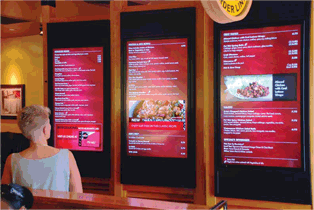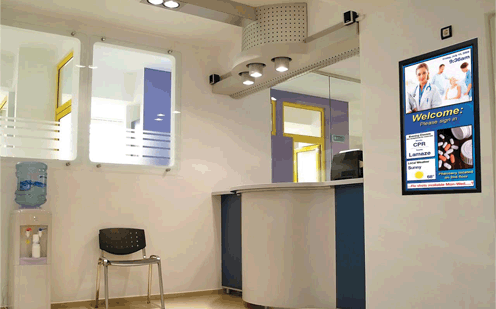Digital Signage Growth Expected In Hospitality And Healthcare, While Retail Gets A New Twist
There has been significant growth for the digital signage industry as a whole, according to recent market research from iSuppli, with indoorvenue and hospitality markets driving the biggest growth opportunities for providers of digital signage solutions. The indoor-venue segment accounts for 26 percent of the total digital signage and professional market revenue.
Black Box telehealth advances the concept of waiting room information, and shares up-to-thesecond information with patients.
Lynn Stearn, VP sales, SunBriteTV, said it is not just in-door bids that are growing; outdoor applications are also in demand. “With the ever-increasing digital world technology, Sunbrite’s clients (digital signage contractors and integrators) are looking to satisfy the needs of their customers for instant news and product upgrades for commercial and retail environments.”
She said that the challenge is finding products that will work well outdoors and be cost effective, in comparison to the LED outdoor-rated technology that worked for billboard signage, but was far too expensive for smaller venues. SunBriteTV addresses those concerns, she said, with a new product line-up of brighter screens that can be used in both portrait and landscape positions. They will be introduced at the DSE show in 2010.
Black Box Corporation, a provider of communications and data infrastructure solutions, says that while general trends reflect growth in retail, backed by the iSuppli data, Black Box has different sweet spots: regional growth, including small- to medium-sized businesses, healthcare, and education. “We have a network of partners and resellers devoted to supporting dealers’ regional opportunities,” explained Steve Acquista, director of digital signage.
Healthcare is a specific bright spot for Black Box, Acquista added. From doctors on the cutting edge, to digital signage in hospital cafeterias, savvy systems installers are finding new sales in medical arena. The iCompel brand is the lead platform for Black Box signage solutions, including telehealth applications.
“Hospitals have multiple waiting rooms and cafeterias, so signage fits in there,” Acquista said. “There are needs for dynamic status boards, communications signage, and education within the hospital setting.”
Whether it is retail, teleheath, or hospitality signage, value is important, said ZeeVee’s Chris Bauer, director of marketing. “The top trend we’re seeing in digital signage is the clients’ desire to reduce the cost of deployment,” he noted.

NEC provides appetizing digital solutions for Pei Wei restaurant menu boards.
Traditional systems featuring a signage player at each display can be expensive, and a tough sell. But when integrators hear they can use a ZvBox to distribute a single signage player to any number of displays, often over existing coax cabling, Bauer said, “their eyes light up.”
It’s all a rosy forecast from the manufacturers’ perspective, but what about the contractor installing these next-gen digital signage solutions? AVT Communiqué, a Chicago- based contractor, agrees that hospitality is a growth area. “At AVT, we’ve installed numerous NEC 40- and 46-inch LCD panels including the Grand Hyatt New York, as part of a major digital signage initiative,” said David Alter, director of engineering and project management, AVT Communiqué.
What Alter appreciates are the features that allow his team to take advanced control over the displays for digital signage applications. Those specific features are: “Power scheduling and long cable color timing adjustments to help eliminate ghosting and blurry images.”
Features like those, and streamlined operation, are necessary to increase deployment of solutions across vertical markets in 2010, said Mike Zmuda, director of business development for NEC Display Solutions. “A lot of owners of digital signage systems have been looking for simplicity in network operation, and an easy way to earn advertising revenue to pay for the system,” he said.
NEC expects these issues to be addressed with the new VUKUNET platform to allow these operators to automatically connect with advertisers and fulfill this revenue and operational need.
“Resellers and installers can also be part of the advertising revenue stream when they register these networks on VUKUNET,” Zmuda added, “which is a new twist that the reseller community will be happy to see.”
Margot Douaihy has covered trends in residential and commercial systems integration for 10 years. She is a contributing editor of Residential Systems magazine and frequent writer for SCN.











